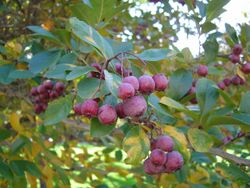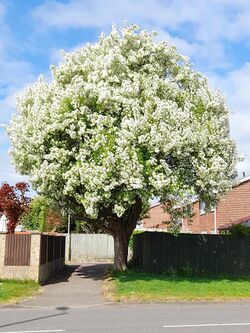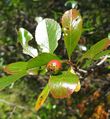Biology:Crataegus crus-galli
| Crataegus crus-galli | |
|---|---|

| |
| A cultivated form | |
| Scientific classification | |
| Kingdom: | Plantae |
| Clade: | Tracheophytes |
| Clade: | Angiosperms |
| Clade: | Eudicots |
| Clade: | Rosids |
| Order: | Rosales |
| Family: | Rosaceae |
| Genus: | Crataegus |
| Section: | Crataegus sect. Coccineae |
| Series: | Crataegus ser. Crus-galli |
| Species: | C. crus-galli
|
| Binomial name | |
| Crataegus crus-galli | |
| Synonyms[1] | |
|
Synonyms list
| |
Crataegus crus-galli is a species of hawthorn known by the common names cockspur hawthorn and cockspur thorn. It is native to eastern North America from Ontario to Texas to Florida, and it is widely used in horticulture.[2][3] It is thought to be the parent, along with Crataegus succulenta, of the tetraploid species Crataegus persimilis.
Description
This is a small tree growing up to about 10 meters tall and 8 meters wide, rounded in form when young and spreading and flattening as it matures. The leaves are 5 to 6 centimeters long, glossy dark green in color and turning gold to red in the fall. The flowers are white and have a scent generally considered unpleasant. The fruits are small pomes that vary in colour, usually a shade of red.[3] Most wild varieties[specify] of the tree are heavily armed in sharp thorns several centimeters long.[citation needed]
Cultivation
This species is a popular ornamental tree, especially var. inermis, which lacks thorns. Many other wild forms would be very suitable for landscaping if better known, and yellow-fruited forms exist.[3]
Uses
The fruit is edible and can be made into jelly or crushed to make tea.[4]
Images
See also
References
- ↑ Phipps, J.B. (2015), "Crataegus crus-galli Linnaeus", in L. Brouillet; K. Gandhi; C.L. Howard et al., Flora of North America North of Mexico, 9: Magnoliophyta: Picramniaceae to Rosaceae, New York, Oxford: Oxford University Press, pp. 538–619
- ↑ "Crataegus crus-galli L.". Natural Resources Conservation Service PLANTS Database. USDA. https://plants.usda.gov/core/profile?symbol=CRCR2.
- ↑ 3.0 3.1 3.2 Phipps, J.B.; O’Kennon, R.J.; Lance, R.W. (2003). Hawthorns and medlars. Cambridge, U.K.: Royal Horticultural Society. ISBN 0-88192-591-8. https://archive.org/details/hawthornsmedlars00jame.
- ↑ Elias, Thomas S.; Dykeman, Peter A. (2009). Edible Wild Plants: A North American Field Guide to Over 200 Natural Foods. New York: Sterling. pp. 237–38. ISBN 978-1-4027-6715-9. OCLC 244766414. https://www.worldcat.org/oclc/244766414.
External links
Wikidata ☰ Q916961 entry
 |








